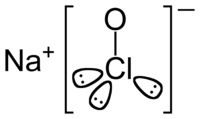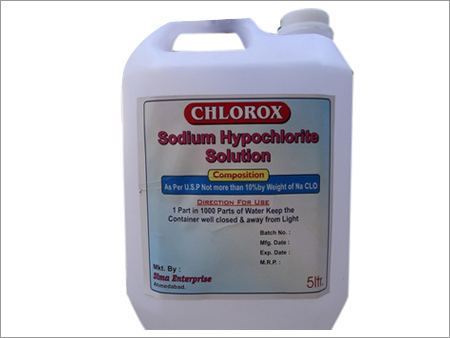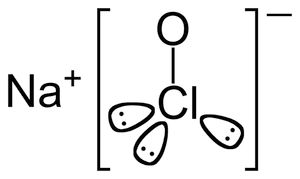Related compounds Density 1.11 g/cm³ Boiling point 101 °C Soluble in Water | Formula NaClO Molar mass 74.44 g/mol Melting point 18 °C | |
 | ||
Appearance greenish-yellow solid (pentahydrate) | ||
Sodium hypochlorite is a chemical compound with the formula NaClO. It is composed of a sodium cation (Na+
) and a hypochlorite anion (ClO−
); it may also be viewed as the sodium salt of hypochlorous acid. When dissolved in water it is commonly known as bleach or liquid bleach. Sodium hypochlorite is practically and chemically distinct from chlorine. Sodium hypochlorite is frequently used as a disinfectant or a bleaching agent.
Contents
- Bleaching
- Stain removal
- Disinfection
- Deodorizing
- Water treatment
- Endodontics
- Nerve agent neutralization
- Reduction of skin damage
- Safety
- Production
- Other production routes
- Packaging and sale
- Reactions
- Neutralization
- References

Bleaching

Household bleach is, in general, a solution containing 3–8% sodium hypochlorite and 0.01–0.05% sodium hydroxide; the sodium hydroxide is used to slow the decomposition of sodium hypochlorite into sodium chloride and sodium chlorate.
Stain removal

Sodium hypochlorite has destaining properties. Among other applications, it can be used to remove mold stains, dental stains caused by fluorosis, and stains on crockery, especially those caused by the tannins in tea. It has also been used in laundry detergents.
Disinfection

Sodium hypochlorite in solution exhibits broad spectrum anti-microbial activity and is widely used in healthcare facilities in a variety of settings. It is usually diluted in water depending on its intended use.

A weak solution of 2% household bleach in warm water is used to sanitize smooth surfaces prior to brewing of beer or wine. Surfaces must be rinsed to avoid imparting flavors to the brew; the chlorinated byproducts of sanitizing surfaces are also harmful. The mode of disinfectant action of sodium hypochlorite is similar to that of hypochlorous acid.

US government regulations allow food processing equipment and food contact surfaces to be sanitized with solutions containing bleach, provided that the solution is allowed to drain adequately before contact with food, and that the solutions do not exceed 200 parts per million (ppm) available chlorine (for example, one tablespoon of typical household bleach containing 5.25% sodium hypochlorite, per gallon of water). If higher concentrations are used, the surface must be rinsed with potable water after sanitizing.
Strong chlorine solution made with household bleach is used for disinfecting areas contaminated with body fluids, including large blood spills (the area must first be cleaned with detergent before it can be disinfected). This 1:10 dilution of 5.25%–6.15% sodium hypochlorite with water (1 part bleach to 9 parts water) yields between 5250–6150 ppm available chlorine and is able to inactivate both C Diff and HPV.
Dilutions containing more than 500ppm available chlorine are corrosive to some metals, alloys and many thermoplastics (such as acetal resin) and need to be thoroughly removed afterwards, so the bleach disinfection is sometimes followed by an ethanol disinfection. Liquids containing sodium hypochlorite as the main active component are also used for household cleaning and disinfection, for example toilet cleaners. Some cleaners are formulated to be thick so as not to drain quickly from vertical surfaces, such as the inside of a toilet bowl.
Neutrophils of the human immune system produce small amounts of hypochlorite inside phagosomes, which digest bacteria and viruses.
Deodorizing
Sodium hypochlorite has deodorizing properties, which go hand in hand with its cleaning properties.
Water treatment
Sodium hypochlorite solutions have been used to treat dilute cyanide waste water, such as electroplating wastes. In batch treatment operations, sodium hypochlorite has been used to treat more concentrated cyanide wastes, such as silver cyanide plating solutions. Toxic cyanide is oxidized to cyanate (OCN−) that is not toxic, idealized as follows:
CN− + OCl− → OCN− + Cl−Sodium hypochlorite is commonly used as a biocide in industrial applications to control slime and bacteria formation in water systems used at power plants, pulp and paper mills, etc., in solutions typically of 10–15% by weight.
Endodontics
Sodium hypochlorite is the medicament of choice due to its efficacy against pathogenic organisms and pulp digestion in endodontic therapy. Its concentration for use varies from 0.5% to 5.25%. At low concentrations it dissolves mainly necrotic tissue; at higher concentrations it also dissolves vital tissue and additional bacterial species. One study has shown that Enterococcus faecalis was still present in the dentin after 40 minutes of exposure of 1.3% and 2.5% sodium hypochlorite, whereas 40 minutes at a concentration of 5.25% was effective in E. faecalis removal. In addition to higher concentrations of sodium hypochlorite, longer time exposure and warming the solution also increases its effectiveness in removing soft tissue and bacteria within the root canal chamber. 2% is a common concentration as there is less risk of an iatrogenic hypochorite incident. A hypochlorite incident is an immediate reaction of severe pain, followed by edema, haematoma, and ecchymosis as a consequence of the solution escaping the confines of the tooth and entering the periapical space. This may be caused by binding or excessive pressure on the irrigant syringe, or it may occur if the tooth has an unusually large apical foramen.
Nerve agent neutralization
At the various nerve agent (chemical warfare nerve gas) destruction facilities throughout the United States, 50% sodium hypochlorite is used to remove all traces of nerve agent or blister agent from Personal Protection Equipment after an entry is made by personnel into toxic areas. 50% sodium hypochlorite is also used to neutralize any accidental releases of nerve agent in the toxic areas. Lesser concentrations of sodium hypochlorite are used in similar fashion in the Pollution Abatement System to ensure that no nerve agent is released in furnace flue gas.
Reduction of skin damage
Dilute bleach baths have been used for decades to treat moderate to severe eczema in humans, but it has not been clear why they work. According to work published by researchers at the Stanford University School of Medicine in November 2013, a very dilute (0.005%) solution of sodium hypochlorite in water was successful in treating skin damage with an inflammatory component caused by radiation therapy, excess sun exposure or aging in laboratory mice. Mice with radiation dermatitis given daily 30-minute baths in bleach solution experienced less severe skin damage and better healing and hair regrowth than animals bathed in water. A molecule called nuclear factor kappa-light-chain-enhancer of activated B cells (NF-κB) is known to play a critical role in inflammation, ageing, and response to radiation. The researchers found that if NF-κB activity was blocked in elderly mice by bathing them in bleach solution, the animals' skin began to look younger, going from old and fragile to thicker, with increased cell proliferation. The effect diminished after the baths were stopped, indicating that regular exposure was necessary to maintain skin thickness.
Safety
Sodium hypochlorite is a strong oxidizer. Oxidation reactions are corrosive. Solutions burn the skin and cause eye damage, especially when used in concentrated forms. However, as recognized by the NFPA, only solutions containing more than 40% sodium hypochlorite by weight are considered hazardous oxidizers. Solutions less than 40% are classified as a moderate oxidizing hazard (NFPA 430, 2000).
Mixing bleach with some household cleaners can be hazardous. For example, mixing an acid cleaner with sodium hypochlorite bleach generates toxic chlorine gas. Mixing bleach with amines (for example, cleaning products containing ammonia or related compounds and biological materials such as urine) produces nitrogen trichloride. This gaseous product can cause acute lung injury. Chronic exposure, for example, from the air at swimming pools where chlorine is used as the disinfectant, can lead to the development of atopic asthma.
Bleach can react violently with hydrogen peroxide and produce oxygen gas:
H2O2(aq) + NaClO(aq) → NaCl(aq) + H2O(l) + O2(g)It is estimated that there are about 3300 accidents needing hospital treatment caused by sodium hypochlorite solutions each year in British homes (RoSPA, 2002).
Household bleach and pool chlorinator solutions are typically stabilized by a significant concentration of lye (caustic soda, NaOH) as part of the manufacturing reaction. Skin contact will produce caustic irritation or burns due to defatting and saponification of skin oils and destruction of tissue. The slippery feel of bleach on skin is due to this process.
A European study, published in 2008, indicated that sodium hypochlorite and organic chemicals (e.g., surfactants, fragrances) contained in several household cleaning products can react to generate chlorinated volatile organic compounds (VOCs). These chlorinated compounds are emitted during cleaning applications, some of which are toxic and probable human carcinogens. The study showed that indoor air concentrations significantly increase (8–52 times for chloroform and 1–1170 times for carbon tetrachloride, respectively, above baseline quantities in the household) during the use of bleach containing products. The increase in chlorinated volatile organic compound concentrations was the lowest for plain bleach and the highest for the products in the form of "thick liquid and gel." The significant increases observed in indoor air concentrations of several chlorinated VOCs (especially carbon tetrachloride and chloroform) indicate that the bleach use may be a source that could be important in terms of inhalation exposure to these compounds. The authors suggested that using these cleaning products may significantly increase the cancer risk.
One major concern arising from sodium hypochlorite use is that it tends to form chlorinated organic compounds, some of which are carcinogenic. This can occur during household storage and use as well during industrial use. For example, when household bleach and wastewater were mixed, 1–2% of the available chlorine was observed to form organic compounds. As of 1994, not all the byproducts had been identified, but identified compounds include chloroform and carbon tetrachloride. The estimated exposure to these chemicals from use is estimated to be within occupational exposure limits.
Production
Potassium hypochlorite was first produced in 1789 by Claude Louis Berthollet in his laboratory on the Quai de Javel in Paris, France, by passing chlorine gas through a solution of potash lye. The resulting liquid, known as "Eau de Javel" ("Javel water"), was a weak solution of potassium hypochlorite. Antoine Labarraque replaced potash lye by the cheaper soda lye, thus obtaining sodium hypochlorite (Eau de Labarraque). However, this process was not very efficient, and alternative production methods were sought. One such method involved the extraction of chlorinated lime (known as bleaching powder) with sodium carbonate to yield low levels of available chlorine. This method was commonly used to produce hypochlorite solutions for use as a hospital antiseptic that was sold after World War I under the names "Eusol", an abbreviation for Edinburgh University Solution Of (chlorinated) Lime – a reference to the university's pathology department, where it was developed – and "Dakin's Solution." The UK's National Institute for Health and Care Excellence in October 2008 recommended the preparation should not be used in routine wound care.
Near the end of the nineteenth century, E. S. Smith patented the chloralkali process: a method of producing sodium hypochlorite involving the electrolysis of brine to produce sodium hydroxide and chlorine gas, which then mixed to form sodium hypochlorite. Both electric power and brine solution were in cheap supply at the time, and various enterprising marketers took advantage of the situation to satisfy the market's demand for sodium hypochlorite. Bottled solutions of sodium hypochlorite were sold under numerous trade names.
Today, an improved version of this method, known as the Hooker process (named after Hooker Chemicals, acquired by Occidental Petroleum), is the only large scale industrial method of sodium hypochlorite production. In the process, sodium hypochlorite (NaClO) and sodium chloride (NaCl) are formed when chlorine is passed into cold dilute sodium hydroxide solution. It is prepared industrially by electrolysis with minimal separation between the anode and the cathode. The solution must be kept below 40 °C (by cooling coils) to prevent the undesired formation of sodium chlorate.
Cl2 + 2 NaOH → NaCl + NaClO + H2OHence, chlorine is simultaneously reduced and oxidized; this process is known as disproportionation.
Commercial solutions always contain significant amounts of sodium chloride (common salt) as the main by-product, as seen in the equation above.
Other production routes
Sodium hypochlorite can be easily produced for research purposes by reacting ozone with salt.
NaCl + O3 → NaClO + O2This reaction happens at room temperature and can be helpful for oxidizing alcohols.
Packaging and sale
Like many hypochlorites, anhydrous NaClO obtained by desiccation of the pentahydrate will decompose violently on heating or friction. However, it is more stable in cold dilute solutions.
Household bleach sold for use in laundering clothes is a 3–8% solution of sodium hypochlorite at the time of manufacture. Strength varies from one formulation to another and gradually decreases with long storage.
A 10–25% solution of sodium hypochlorite is, according to Univar's safety sheet, supplied with synonyms or trade names bleach, Hypo, Everchlor, Chloros, Hispec, Bridos, Bleacol, or Vo-redox 9110.
A 12% solution is widely used in waterworks for the chlorination of water, and a 15% solution is more commonly used for disinfection of waste water in treatment plants. Sodium hypochlorite can also be used for point-of-use disinfection of drinking water.
Dilute solutions (50 ppm to 1.5%) are found in disinfecting sprays and wipes used on hard surfaces.
Reactions
Sodium hypochlorite reacts with hydrochloric acid to release chlorine gas:
NaClO + 2 HCl → Cl2 + H2O + NaClIt reacts with other acids, such as acetic acid, to release hypochlorous acid:
NaClO + CH3COOH → HClO + CH3COONaIt decomposes when heated, forming sodium chlorate and sodium chloride:
3 NaClO → NaClO3 + 2 NaClWhen dissolved in water it slowly decomposes, releasing sodium ions, chloride ions, and hydroxyl radicals:
NaClO + H2O → Na+ + Cl− + 2 HO•These hydroxyl radicals can oxidize organic compounds or self-react to form water and oxygen:
R-CH2-OH + 4 HO• → R-COOH + 3 H2O 4 HO• → 2 H2O + O2(dissolved or gas)In a NaClO solutions, the following species are thought to be present when the system is in equilibrium. Note that NaCl may be in excess due to the manufacturing process (bubbling chlorine gas through sodium hydroxide NaOH). The free chlorine is thought to be modulated by pH and NaCl as indicated by mercury-chlorine byproducts.
HOCl ↔ H+ + OCl− HOCl + Cl− + H+ ↔ Cl2 + H2OThe ratio of Cl2 : HOCl : OCl− is pH dependent. The above equations show that the "byproduct" Cl− ions (from the NaCl) play a rarely mentioned role, without them there would be no available chlorine in the solution.
Sodium hypochlorite reacts with most nitrogen compounds to form volatile chloramines, dichloramines, and nitrogen trichloride:
NH3 + NaClO → NH2Cl + NaOH NH2Cl+ NaClO → NHCl2 + NaOH NHCl2 + NaClO → NCl3 + NaOHIn the presence of a phase-transfer catalyst, alcohols are oxidized to the corresponding carbonyl compound.
Heterogeneous reactions of sodium hypochlorite and metals such as zinc proceed slowly to give the metal oxide or hydroxide:
NaClO + Zn → ZnO + NaClHomogeneous reactions with metal coordination complexes proceed somewhat faster. This has been exploited in the Jacobsen epoxidation.
As an oxidant, sodium hypochlorite decomposes to sodium chloride and oxygen: NaClO → NaCl + [O]
Neutralization
Sodium thiosulfate is an effective chlorine neutralizer. Rinsing with a 5 mg/L solution, followed by washing with soap and water, will remove chlorine odor from the hands.
